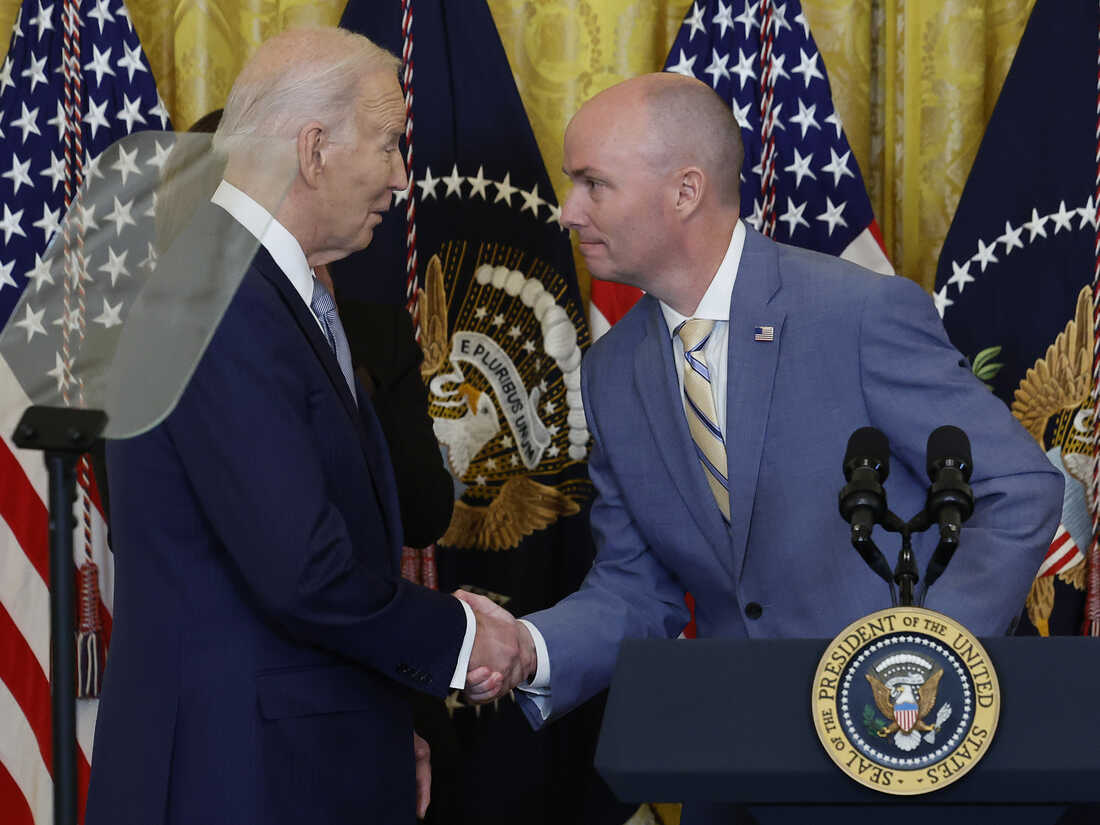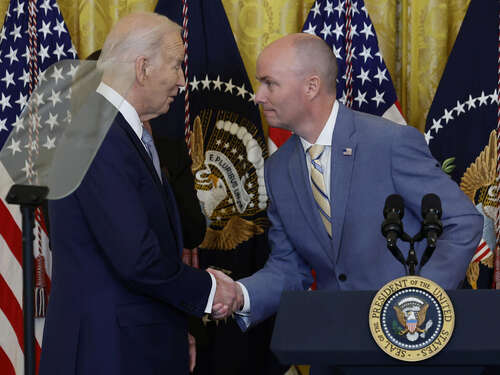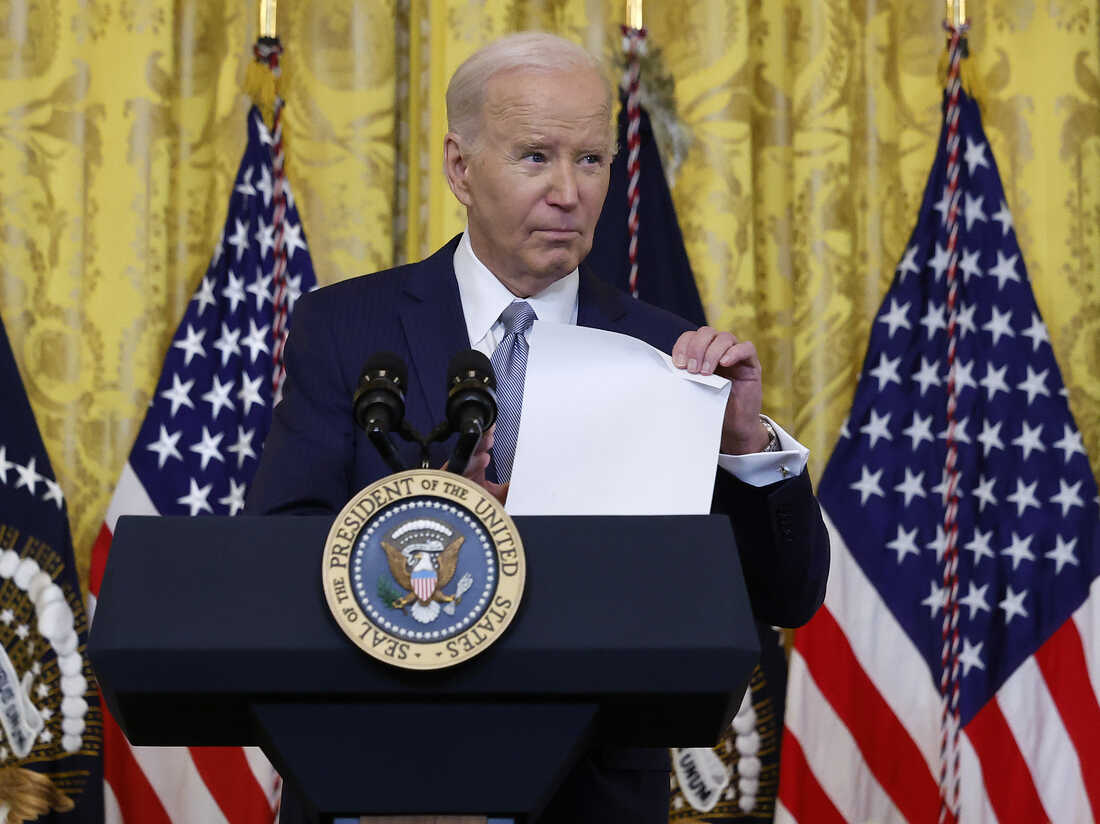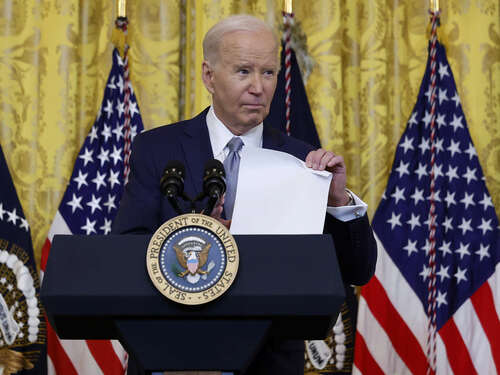
President Biden shakes hands with Utah Gov. Spencer Cox during a meeting with governors from across the country at the White House on Feb. 23.
Chip Somodevilla/Getty Images
hide caption
toggle caption
Chip Somodevilla/Getty Images

President Biden shakes hands with Utah Gov. Spencer Cox during a meeting with governors from across the country at the White House on Feb. 23.
Chip Somodevilla/Getty Images
President Biden told governors on Friday that he is looking at options for executive action to curb the flow of migrants across the southern U.S. border but said that existing laws and a lack of funding were limiting his choices.
The White House has been considering its next steps since Republicans in Congress backed away from a Senate compromise that would have empowered the administration to turn away migrants seeking asylum when certain thresholds were reached. The failed bill would have provided about $20 billion for border personnel — as well as aid for states and cities that have exhausted their resources while grappling with record numbers of asylum-seekers.
The border has become a major issue in the presidential election, with a recent NPR/PBS Newshour/Marist poll showing only 29% of respondents approving of how Biden is handling immigration.
White House press secretary Karine Jean-Pierre said no decisions have been made on executive actions on the border, and declined comment on any specific option being considered. But Biden told governors it’s something he’s examining.
“He did say that he has been working with his attorneys, trying to understand what executive action would be upheld in the courts and would be constitutional,” said Utah Gov. Spencer Cox, a Republican.
“He seemed a little frustrated that he was not getting answers from attorneys that felt he could take the kind of actions that he wanted to,” Cox told reporters after a meeting Biden held with the National Governors Association.

President Biden holds up a fact sheet about the failed Senate deal on border security while speaking to governors at the White House on Feb. 23.
Chip Somodevilla/Getty Images
hide caption
toggle caption
Chip Somodevilla/Getty Images

President Biden holds up a fact sheet about the failed Senate deal on border security while speaking to governors at the White House on Feb. 23.
Chip Somodevilla/Getty Images
What could Biden do on his own?
There was a spate of stories this week that Biden would try to implement a major feature of the failed Senate bill on his own: a measure that would block new asylum claims when the number of migrants outpace the ability of border officials to process them.
Biden had previously described this measure from the bill as giving him the power to “shut down the border.” But he had insisted he could only take that step if Congress passed the bill.
On Friday, Biden did not share specific details about what he was looking at doing, Cox said.
But the president said he lacked funding for more border patrol agents and judges to address the backlog in asylum cases — funding that had been part of the failed Senate border package, Colorado Gov. Jared Polis, a Democrat, told reporters.
“He indicated that they’re actively looking into these [options], but what he brought it back to — and I think we as governors get this — we don’t have the power of the purse. Our legislators do,” Polis said.
“We did get a general sense that they’re looking into whatever they can do on the executive side. Again, keeping our expectations realistic, that’s going to be more limited than a congressional solution,” Polis said.

Brenda Romero distributes food to migrants at the La Colaborativa day shelter in Chelsea, Mass., on Feb. 22. The shelter provides services to migrants,
Joseph Prezioso/AFP via Getty Images
hide caption
toggle caption
Joseph Prezioso/AFP via Getty Images

Brenda Romero distributes food to migrants at the La Colaborativa day shelter in Chelsea, Mass., on Feb. 22. The shelter provides services to migrants,
Joseph Prezioso/AFP via Getty Images
Unilateral actions would face legal challenges
Republicans have insisted that Biden already has the power he needs to clamp down on asylum seekers. But immigration experts say there are only a few options that would avoid court challenges, and note that lack of funding is an issue.
The vast majority of people who seek asylum ultimately don’t qualify for it. But right now, there is a five- to seven-year backlog to assess asylum cases — years where migrants are allowed to stay in the country to wait for their hearings.
“What would make a meaningful difference in deterrence would be if asylum decisions can be made in a much more timely fashion,” said Doris Meissner, senior fellow with the Migration Policy Institute, a nonpartisan think-tank.
But that would require more border patrol officers and judges, and resources to quickly return people to their home countries, she said.
Former President Donald Trump tried several executive actions to restrict immigration when he was in office, but those were blocked by lawsuits. Former President Barack Obama also ran into lawsuits for acting unilaterally on immigration law.
“One of the reasons why asking a president to continue to act under executive authority is problematic is because what we’ve seen is that increasingly it doesn’t matter what policy an administration tries to do — they will get taken to court by somebody who wishes they would have done a different policy,” said Theresa Cardinal Brown of the Bipartisan Policy Center, in an interview.



